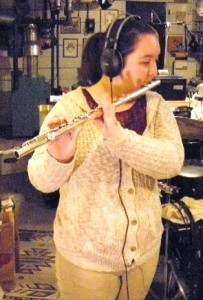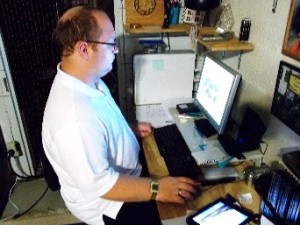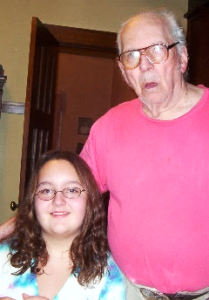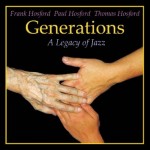 Over the years I’ve recorded a lot of music but none has proven more challenging — nor more rewarding — than the CDs Generations and Yesterdays. Both feature my father, Frank, at the very end of his life while Generations also includes my children Thomas and Angela.
Over the years I’ve recorded a lot of music but none has proven more challenging — nor more rewarding — than the CDs Generations and Yesterdays. Both feature my father, Frank, at the very end of his life while Generations also includes my children Thomas and Angela.
Below is the story of this project; because Generations took much more effort and time to produce, most of what follows deals with its creation.
The Story of Generations and Yesterdays
My love of music and recording were both inherited from my father, pianist Frank Hosford, who had me playing piano and guitar long before I started school. He passed a rich legacy of music on to me, and then, in the final two years of his life, helped me pass that legacy on to my children. This is the story of how this happened and of the CDs Yesterdays and Generations which took form as a result.
Yesterdays and its sister CD, Generations, are the culmination of my efforts to preserve as much as I could of my father Frank’s musical legacy during the final years of his life. Frank had started playing piano eight decades earlier when he was only five. In his 80s Frank’s health began to fail and after a series of falls he had to move into a nursing home.
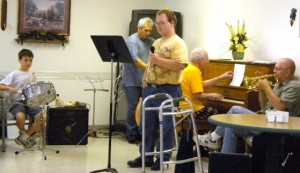 To raise his spirits I brought him jazz CDs and magazines every chance I could, and we even performed concerts with his friends and family at the nursing home.
To raise his spirits I brought him jazz CDs and magazines every chance I could, and we even performed concerts with his friends and family at the nursing home.
But Frank didn’t much like having other people listen to him so I bought him a keyboard he could play while wearing headphones. And he spent a lot of time doing so.
One day we got to talking about the songs he 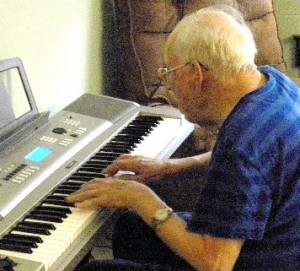 remembered from his childhood. One was Smoke Gets In Your Eyes. I asked him to play it on his keyboard and pushed the built-in record button when he began. The keyboard could hold up to five songs at a time, and I had him fill its memory with unrehearsed solo renditions of jazz classics.
remembered from his childhood. One was Smoke Gets In Your Eyes. I asked him to play it on his keyboard and pushed the built-in record button when he began. The keyboard could hold up to five songs at a time, and I had him fill its memory with unrehearsed solo renditions of jazz classics.
It was great to get his playing saved; I’d recorded him now and then in the past but had never been satisfied with the results. So though he’d played a lot over the years, comparatively little of it had been preserved. But more important than saving his music was that working on music “kept him going” as he once put it.
As soon as I could I began recording him playing not only jazz standards but also the original tunes he’d composed over the years. Our plan was to produce two CDs — a solo keyboard CD of standards and an original CD where I would add instruments like bass, guitar and drums to his piano and organ parts.
Little did I know it would take three years to complete these recordings — or that Frank wouldn’t live to hear the final results. Because of his declining health, Frank’s parts had to be recorded in his room at the nursing home, and this required moving a lot of equipment back and forth. He’d also forgotten many of his original tunes, but by playing what I could remember of them he was slowly able to get them back.
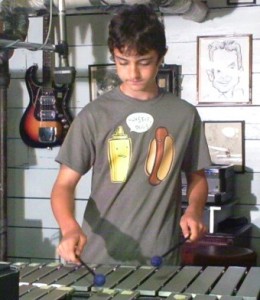 About seven months into this project my 13-year-old son, Thomas, approached me saying, “Dad, can we talk?” I had no idea what was coming but Thomas, then a percussionist in his middle school band, said he’d like to play the vibraphone – a mallet instrument similar to a xylophone and used frequently in jazz — with his grandfather and me. I was delighted that Thomas wanted to join our family recording project, and I immediately began rearranging the original tunes to include parts for Thomas to play on vibes.
About seven months into this project my 13-year-old son, Thomas, approached me saying, “Dad, can we talk?” I had no idea what was coming but Thomas, then a percussionist in his middle school band, said he’d like to play the vibraphone – a mallet instrument similar to a xylophone and used frequently in jazz — with his grandfather and me. I was delighted that Thomas wanted to join our family recording project, and I immediately began rearranging the original tunes to include parts for Thomas to play on vibes.
We were fortunate to get Frank’s solo CD, Yesterdays, finished before his sudden death in December of 2013. We were also fortunate to have made at least rough mixes of all of the original tunes that make up Generations, which we listened to with Frank after Thanksgiving dinner in 2013.
Frank listened to these mixes in silence. When the last tune was finished I asked what he thought, and he replied that he was “baffled.” I wasn’t expecting this response – I was hoping he’d be excited. When I asked him why he was baffled, he said it was because he couldn’t figure out how an old man, a boy just learning to play, and a guy putting it all together in an unfinished basement – all in the middle of rural Nebraska, no less — had managed to accomplish so much.
Producing these CDs has been a family affair – not only has my son Thomas been an integral part of it, my daughter Angela plays flute on the song Pickle Puss while my older son, William, handled both the photography and the graphics layout for Generations. And my wife Lori came up with the cover concept for Generations as well as supporting us every step of the way.
The Music
While the songs on Yesterdays are all jazz standards, all the tunes on Generations are original and each has its own story. To learn more about Yesterdays and hear the tracks, please click. To learn more about Generations and hear those tracks, please keep reading.
Her Eyes The melody to this tune came to me in the 1990s while my family and I were driving through Omaha on a rainy afternoon — the only thing we could find to write it down on was a deposit slip from Lori’s checkbook. I recorded the guitar part after finishing my first CD, Emergence, in 2002, but I didn’t get the rest of the song finished until 2013.
Thunder Lizard This instrumental by Frank was inspired by the compositions of jazz bassist Charlie Mingus. Frank recorded both the piano and organ parts in the nursing home, and it was the first of Frank’s compositions that Thomas played vibes on.
Sailin’ This piece in waltz time was Frank’s favorite – and perhaps most challenging – composition. It’s based on the blues but expands upon the basic blues form by adding additional measures. Thomas’ vibes solo includes a 4/4 pattern of phrases imposed over the 3/4 meter of the song.
Ghost Of A Dance One of Frank’s ballads (the title alludes to the jazz classic Ghost Of A Chance), Thomas’ band director, Whitney Paulson, joins us here on violin.
Trialogue Frank originally wrote this piece as a duet for bass and piano entitled Duologue. Frank asked me to add Thomas on vibes and we changed the title accordingly.
Medley: Jubilation/Take A Chance Thomas really likes the evocative qualities of Jubilation, saying it reminds him of lying on the grass watching clouds drift past. Take A Chance has lyrics (as do many of our compositions) and I may record it again as a vocal someday…
Yesterday’s Dreams After Thomas told me he wanted to play the vibes, his band director loaned us the school’s old set. We had to make some repairs to get the motor working and had to remove two doors to get the vibraphone into my basement recording studio. I then wrote out the melody and a solo to this ballad I’d composed decades ago.
Thomas did so well on this that we decided to make a music video. We purchased several inexpensive camcorders and a program that would let us synchronize them to each other and to the music. Everything that could go wrong did, but my older son, William, did a great job of piecing things together and adding titles and graphics.
Jump! This is a fun little tune I wrote and recorded the guitar part for back in 2002. After Thomas became involved with Generations, I added bass and drums and wrote him into the arrangement.
Alligator Wine I wrote this when I was 16 or 17 years old. We were on vacation at Niobrara State Park in northeast Nebraska, and I whiled away the time listening to – and composing – music in my head. Though I originally titled it Niobrara Blues, I changed the title while recording it, adopting the one Frank suggested based on a bizarre beverage he’d read about. I play electric piano, and Thomas and I are joined by our good friend, Rich Hughes, who plays cup mute trumpet.
What Might Have Been This is one of my favorite compositions, a ballad I wrote in December of 1992 while waiting for a friend and his new wife to make the drive to Albion from their home in Chicago. I again play the electric piano part.
Movin’ Along Frank wrote a number of songs over the years, but this one had been completely forgotten until I found it by accident on an unlabeled cassette. I recorded the basic arrangement and then played it for Frank after Christmas dinner in 2013. Frank suggested several changes (which I made) and together the family gave it its title. Rich Hughes again joins us here on muted trumpet.
This was the last song Frank was involved with – he passed away unexpectedly a day and a half after we began working on this song…
Who’d ‘ave Believed My great-uncle, Richard Mansfield, rode a horse to school and the only instrument he could fit in his saddle bag was a flute. On his last visit back to Albion in the mid-1970s, Richard brought his flute and he, Frank, my grandfather Russ and I jammed each evening for a week. At the end of his visit he handed me the flute and said, “Here — learn to play it.” Unfortunately, I don’t play flute as much as I do bass and guitar, but I wanted to honor Richard’s memory by featuring the flute on this song.
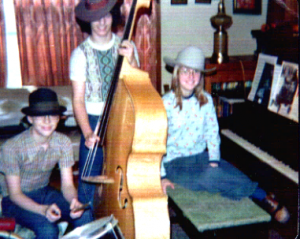 Pickle Puss Frank wrote this song for a little musical group I had in the eighth through tenth grades, but we unfortunately never got around to learning it (pictured with me on the left are Ken Olnes on drums and Laurel Tisthammer on piano, circa 1975). Pickle Puss was the last song Frank ever recorded, saying when we finished that he thought he was “finally played out.”
Pickle Puss Frank wrote this song for a little musical group I had in the eighth through tenth grades, but we unfortunately never got around to learning it (pictured with me on the left are Ken Olnes on drums and Laurel Tisthammer on piano, circa 1975). Pickle Puss was the last song Frank ever recorded, saying when we finished that he thought he was “finally played out.”
This last recording session took place in Frank’s room at the nursing home and during it a stranger heard us and came in. He explained he had a country band and wondered if I would play bass in it. I politely explained that we were recording and he apologized and left. I may have missed my chance to make it big in Nashville, but I thought it best to finish the recording – and the album – before joining a band.
My daughter Angela plays flute on this track. She had played while in school but had stopped when she went to college. Since Frank had had a flute in mind when he wrote this tune, I asked Angela to record it with us. She agreed and practiced for several months in order to get her lip back in shape. It was wonderful to be able to include her in this family project especially since this was Frank’s last recording.
Persimmon I wrote this for Angela before she was born (we called her “Persimmon” then). It’s a quirky piece that goes through several time signatures. I originally wrote this out for Thomas to play on his set of bells. Thomas worked hard to learn it and practiced so much that he was able to record it the very next day. He later re-recorded it on vibes. I accompany him on electric piano.
How Generations Was Recorded
How Recordings Are Made
Until the late 1940s, musical groups that made records had to all perform together in the recording studio. But after World War II guitarist Les Paul began experimenting with tape recorders. Paul developed what came to be known as “multi-track” recording, a technique that divides recording tape into multiple strips, or “tracks,” each of which can contain a different sound.
Paul and his wife Mary Ford used this technique to “overdub” multiple parts into a single song and had many hits in the early 1950s that featured this innovative approach. They would record their basic performance first and then go back and add more guitar parts and vocal harmonies. Though it wasn’t until later that multitrack recording became the norm, it changed the way records were made. Not only did it allow musicians to play or sing multiple parts, it also made fixing mistakes much easier. Recordings could even be made over time so that musicians who couldn’t all be present on the same day could still record together.
As technology improved, multi-track recorders came down in both size and price. By the 1980s, instead of purchasing time to record in expensive studios, musicians could invest in recording equipment of their own. This gave them complete control of the creative process and fueled the development of more and more sophisticated recording techniques and technology.
In the 1990s personal computers became powerful enough to be used for multi-track recording. Musicians no longer had to deal with the noise and other problems that came with using reel-to-reel tape. Their recordings were instead “digitized” and stored on a computer hard drive.
This transition from tape to computer recording allowed a far greater range of editing options and introduced many new sound possibilities. And though some recording engineers and musicians still prefer using tape, nearly all music today is produced on computers. Digitizing music also made it possible for musicians to burn their own CDs. Musicians could now not only produce their own music, they could market it as well. The Internet began to replace the corner record store as the preferred way to buy and sell music and has opened a lot of doors to countless new musicians and musical styles.
Recording Generations
While my father Frank’s solo CD, Yesterdays, did not require multitrack recording, its sister CD, Generations, could not have been made without using this technique. Due to his deteriorating health, Frank could not leave his nursing home to record in my basement studio. Instead, I had to take recording equipment to him and fit it into his cramped room.
By connecting his keyboard to my laptop computer I could record what keys he pressed and how hard he pressed them rather than the sound the keyboard itself produced. This approach enabled me to correct any errors he made, smooth out the tempo and most importantly, use high-quality digitized piano and organ sounds. Just as performances can be digitized, each note on a piano or organ can be (and has been) digitized. This enables a musician to play one instrument and have it come out sounding like another. If we hadn’t used this technique, Frank’s parts would not have sounded the way Frank wanted them to sound.
Not only did Frank want his parts to be played on a piano or organ, he envisioned his original songs being played by an ensemble that included drums, bass and guitar. His keyboard parts were meant to fit with these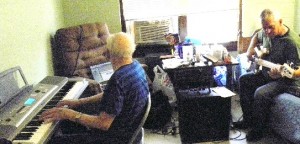 instruments. As a result, Frank preferred that I play bass with him while he recorded. This required me to set up not only my laptop in his room but my bass guitar and a small amplifier as well. Later, I would replace the bass guitar by replaying the parts on a string bass, an instrument that, though more challenging to play, sounds better on Frank’s style of jazz.
instruments. As a result, Frank preferred that I play bass with him while he recorded. This required me to set up not only my laptop in his room but my bass guitar and a small amplifier as well. Later, I would replace the bass guitar by replaying the parts on a string bass, an instrument that, though more challenging to play, sounds better on Frank’s style of jazz.
It’s difficult to run a recorder and play at the same time, and in a room as small as Frank’s it was especially difficult. Often my sons William and/or Thomas would come along to help and this is where Thomas first became immersed in his grandfather’s music. It was this immersion that led Thomas to join our recording project adding vibraphone parts later when back home in our studio.
Creating an ensemble one part at a time is a challenging task. When musicians perform together there’s a lot of interaction taking place. This interplay of ideas is a defining characteristic of live music. Musicians respond to what others are playing, speeding up and slowing down slightly, getting louder and softer and changing their own parts to enhance the emotional feel of a song at each given moment.
Though we used a metronome when recording Frank’s keyboard parts, our tempo still varied here and there according to the demands of the music. These natural variations posed a problem when I started adding rhythm parts. I had to spend a considerable amount of time on each song, subtly adjusting the tempo of Frank’s playing in order to make it possible for me to add additional instruments. Not that he hadn’t played well – it just proved very difficult for me to duplicate the minor tempo variations.
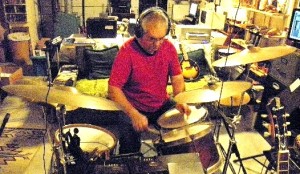 Once I had the tempo smoothed out, I would add other parts. I’d usually start by recording the drums. Then I’d add bass and guitar. In order to make it sound as if an actual drummer, bass player and guitarist were playing together, I would go back and forth among all these instruments, making subtle changes so it sounded more like a group playing together rather than parts that were recorded separately.
Once I had the tempo smoothed out, I would add other parts. I’d usually start by recording the drums. Then I’d add bass and guitar. In order to make it sound as if an actual drummer, bass player and guitarist were playing together, I would go back and forth among all these instruments, making subtle changes so it sounded more like a group playing together rather than parts that were recorded separately.
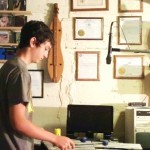 After a solid rhythm section was created, I’d turn my attention to adding solos. Again, I often had to redo parts in order to make it sound as though they were being played by musicians performing together.
After a solid rhythm section was created, I’d turn my attention to adding solos. Again, I often had to redo parts in order to make it sound as though they were being played by musicians performing together.
The next step was to add Thomas on the vibraphone. Frank and I had been working together for several months when Thomas joined us, but I went back and rearranged what we’d already done to make room for the vibes.
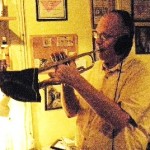 In addition to Thomas, Frank and myself, we were fortunate to be joined by my daughter Angela who, though she hadn’t played flute for several years, practiced for months to play on Frank’s composition Pickle Puss. Thomas’ school band director, Whitney Paulson, played violin on Ghost Of A Dance while our long-time friend and fantastic musician, Rich Hughes, added muted trumpet to Alligator Wine and Movin’ Along and flugelhorn to Pickle Puss.
In addition to Thomas, Frank and myself, we were fortunate to be joined by my daughter Angela who, though she hadn’t played flute for several years, practiced for months to play on Frank’s composition Pickle Puss. Thomas’ school band director, Whitney Paulson, played violin on Ghost Of A Dance while our long-time friend and fantastic musician, Rich Hughes, added muted trumpet to Alligator Wine and Movin’ Along and flugelhorn to Pickle Puss.
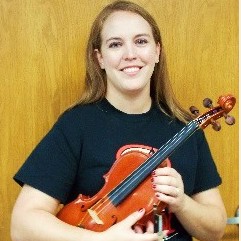 Once all the parts were recorded it was necessary to mix them together. This involved adjusting the volume, tone and dynamics of each instrument throughout the song to make all the different parts blend together.
Once all the parts were recorded it was necessary to mix them together. This involved adjusting the volume, tone and dynamics of each instrument throughout the song to make all the different parts blend together.
All in all, it took about two months to finish each song…
As we proceeded with the project, I began adding songs I’d written so we’d have enough to fill a CD. (Frank and I have both written a number of songs that have lyrics, but because we didn’t have a singer available, we focused on recording our instrumental compositions.)
Once all of the instruments in each of the songs was recorded and mixed together, the songs needed to be sequenced. It was difficult to decide what the optimum sequence should be so that the album would flow smoothly from one song to another. But once this was decided, I sent the sequenced songs to someone called a “mastering engineer” for some finishing touches.
Mastering engineers adjust the individual songs so that the level and tone is consistent from song to song. This was the first time I’d had an album mastered and chose a commercial mastering studio in New Jersey. Since I couldn’t be there to hear what they were doing, they emailed me digital files to listen to at home. I would reply with any changes I wanted and they would make them. Though this added considerably to the cost of the project, the mastering process enhanced the music making it sound more like other commercial jazz recordings.
